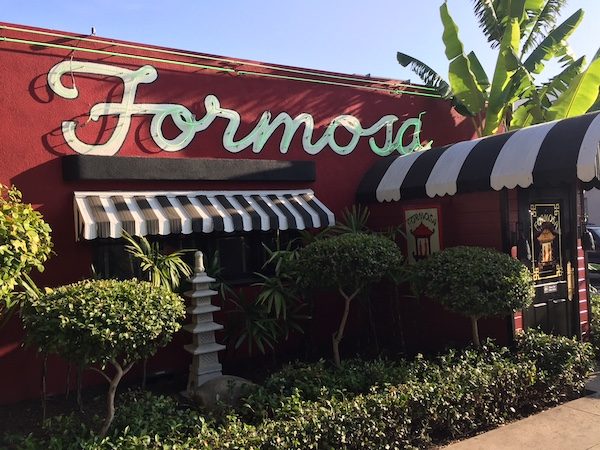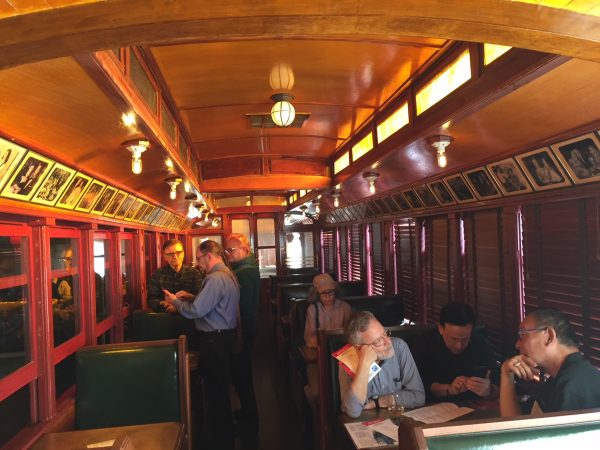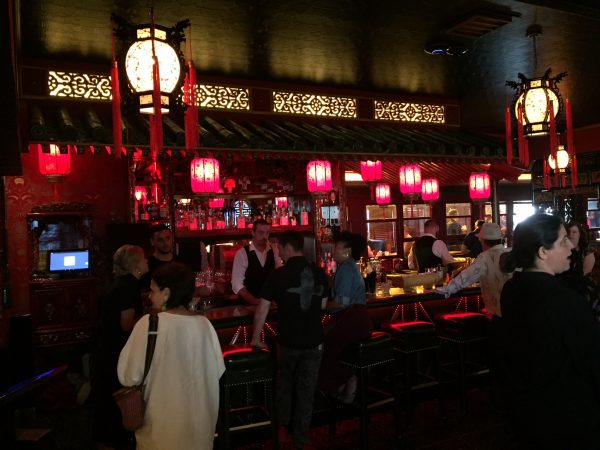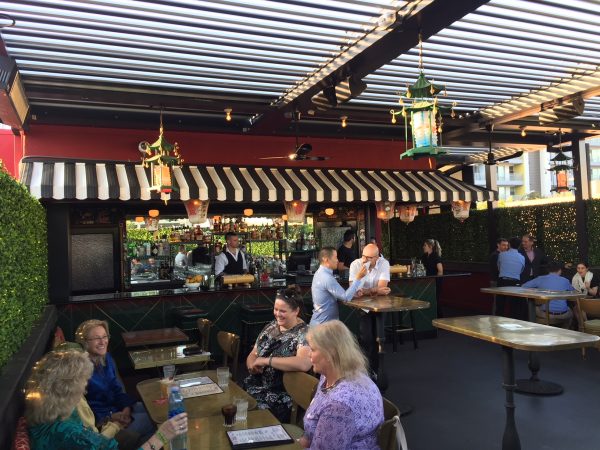
Nostalgia, excitement and hope for the future were in the air Monday night as the City of West Hollywood held its annual historic preservation celebration at the newly restored Formosa Café.
More than 100 residents plus many city officials were on hand to revel in the restoration of the Asian restaurant, which reopened in late June after being closed for almost three years. The overall consensus found the restoration to be an A++ smashing success.
“We’re all super excited to be here at the grand reopening of the famous Formosa,” said Mayor John D’Amico, welcoming guests to the celebration.
D’Amico thanked members of the city’s Historic Preservation Commission for their efforts in making sure places like the Formosa Café get restored and remain vital parts of the city.
D’Amico noted that the Formosa Café has been remodeled several times during its 94-year history and praised the new owner, the 1933 Group, for the superb job they did in restoring the restaurant to its original glory.
“This is by far the most spectacular version [of Formosa Café] of my lifetime,” said D’Amico. “I’m looking forward to coming back many, many times and having wonderful evenings.”
Located in the Gateway Center (home of the Target department store) at 7156 Santa Monica Boulevard, at Formosa Avenue, Formosa Café opened in 1925 and was a favorite watering hole for movie stars, especially when filming at the adjacent movie studio which is now known as The Lot.
The restaurant served what appeared to be its last meal in late 2016. However, in mid-2017, the 1933 Group, which operates 10 bars/restaurants in the Los Angeles area, announced plans to restore the historic restaurant. Among the 1933 Group’s bars is the Harlowe at 7321 Santa Monica Blvd. in West Hollywood.

Bobby Green, chief designer and co-owner of the 1933 Group, explained he frequented the Formosa in the 1980s when he came of drinking age and felt a strong push to keep the wrecking ball away from the building.
“The stories related to actors, related to directors [coming to Formosa Café] over the years is just so massive, tearing a place down like this would be so tragic,” Green told WEHOville. “It was just completely a natural fit for us [the 1933 Group] to do this. We’ve really cut our teeth in restoration. We knew we were the best people to do this place.”
1933 Group, so named because that was the year Prohibition ended, previously restored the barrel-shaped Idle Hour bar in North Hollywood and Highland Bowl bar and bowling alley in Highland Park.
Green said they spent $2.4 million on the Formosa restoration. Painted in a deep red with Chinese lanterns over the tables and photos of movie stars who have dined there on the walls, it feels so authentically 1930s, you almost wonder if you’ve stepped into a time machine upon entering the restaurant.
“This is remarkable, they’ve done a great job,” resident Stephanie Harker commented to WEHOville.
During opening remarks, Adrian Scott Fine, the director of advocacy for the Los Angeles Conservancy preservation group, also praised the extensive and detailed restoration that 1933 Group did.

“Legacy businesses, in general right now across LA, are going away. It’s a touchstone to our past. It’s a way of connecting to our stories and our heritage,” said Fine. “At the Conservancy, we are thrilled when these places re-emerge and re-emerge in a big way like this.”
Oldest Surviving Trolley Car
In addition to its long Hollywood history, the Formosa is also notable because it incorporates one of the original Red Car trolleys into the building. That trolley car, built in 1906 and decommissioned in the 1930s, was added to the building in 1940 and is now the oldest surviving Red Car trolley in America. That’s why the National Trust for Historic Preservation gave a $150,000 grant to help with restoration of the trolley car.
Although restaurant goers have long dined in the trolley car, people on the street often overlooked the trolley portion of the building as it was hidden behind awnings. Green and the 1933 Group removed the awnings, thus making sure the trolley is on display for all to see from the street.
As part of the restoration, they also enclosed the smoking patio and turned it into a back dining area. Green purchased a bar from a now defunct Chinatown restaurant to install in that back area. In researching that bar, he discovered it was built in China and brought to America for use in filming the 1937 movie, “The Good Earth.”
In fact, Green did so much research into the Formosa’s history to make sure they did the restoration properly, 1933 Groups plans to release a book about the Formosa’s history early next year. If time permits, it will also put together an accompanying documentary film.
The West Hollywood Preservation Alliance (WHPA) enthusiastically praised the Formosa restoration.
“The iconic Formosa Cafe on Historic Route 66 played an important role in West Hollywood’s commercial development, especially in the growing film industry, and we’re so pleased that the City Council has designated it as a local historic cultural resource,” WHPA president Victor Omelczenko told WEHOville in an email. WHPA Board Secretary Roy Oldenkamp added: “WHPA would like to give a shout out to historian Stacy Failing, who befriended the owners and persuaded them to save former owner Jimmy Bernstein’s and subsequent owners’ many headshots of celebrities who dined at the Formosa Café over the years. Because of Stacy, we have the original menus, many intact furnishings, even the Chinese lanterns over the banquettes.”
Although legend has it there was a tunnel connecting the movie studio to the Formosa, Green said they found no evidence of a tunnel ever existing.
“I guess the tunnel was just a rumor,” said Green. “But that rumor certainly grew to legendary proportions.”

What’s Next?
With Formosa Café now open to good reviews and rousing business, Green is already eyeing his next project – the Tail o’ the Pup, the old hot dog stand shaped like a hot dog.
The Tail o’ the Pup originally stood on the northwest corner of Beverly and La Cienega boulevards. In the 1980s when the Sofitel Hotel opened in its original location, the Tail o’ the Pup was moved a block away to the northwest corner of Beverly and San Vicente boulevards. Later, it was moved a few hundred feet north to a Cedars Sinai parking lot on San Vicente. It finally closed in 2005 and was put into storage.
1933 Group recently purchased the Tail o’ the Pup building and is looking for a location to put it, with luck somewhere in West Hollywood, or possibly Hollywood. So far, they have not found the right location.
“If anyone knows a good location where we can put the Tail o’ the Pup, please get in touch,” Green said.
During opening comments, Adrian Scott Fine remarked there are many restoration projects the LA Conservancy hopes the 1933 Group will pursue.
“We’re ready to clone them and have them take on many more projects across West Hollywood and Los Angeles,” said Fine.
Fine told WEHOville his dream is for 1933 Group to restore Tom Bergin’s, the historically designated but recently closed 83-year-old Irish bar on Fairfax Avenue, just south of Wilshire Boulevard.
While Green isn’t ruling out eventually purchasing Tom Bergin’s, his ultimate fantasy is to take on a much more ambitious project.
He dreams of rebuilding the Brown Derby, the legendary restaurant that abruptly closed in 1980. It was famous for attracting Hollywood stars and for being shaped like a hat.
“The original hat is now part of a strip mall on Wilshire in Koreatown,” says Green. “I’d love to someday get that hat and find a place to rebuild the Brown Derby.”

Smashing success on the restoration, not so much for the food. On scale of 10 the restoration would be a 9+ but the menu and food perhaps a 4 with some sketchy service on the roof top which was not overly busy.
Thanks for this article and the pictures to go with it!
The Formosa streetcar is hardly different except for tables being where the seats were located. The “Red Cars” were part of the Pacific Electric Railway, the largest electric railway in America, developed by Henry Huntington. All their streetcars were painted red. Huntington sold it to the Southern Pacific Railroad in 1910. If you want to see and ride a PE “red car” streetcar that ran down Santa Monica past the Formosa Cafe visit the Orange Empire Railway Museum in Perris, California. They are open on the weekends located east of Ontario. The museum is amazing. The Los Angeles Times, the… Read more »